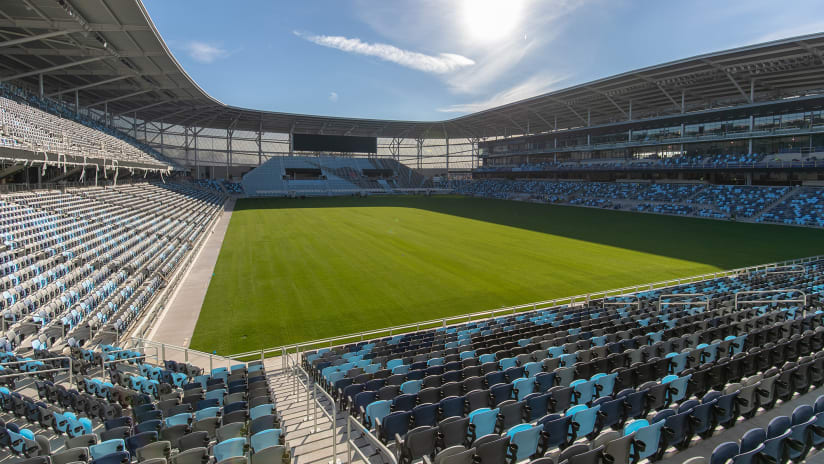With winter fast approaching in the Twin Cities, you’re likely more worried about getting those last leaves up off your lawn when the snow melts than the lawn itself, but if you’re MNUFC Head Groundskeeper Ryan Moy, your concern right now is about the health and well-being of one very specific plot of land: the pitch at Allianz Field.
Moy — who received his Master’s of Agriculture and Horticulture from the University of Minnesota in 2007 before spending over a decade at Hazeltine National Golf Club — became the club’s head groundskeeper when the process of growing the grass for Allianz Field was already well underway out in Colorado, but he wouldn’t have changed a single thing prior to his arrival.
“If we rewind the tape and I was forced to make those decisions and go through that decision-making process,” he said, “I would have hoped to have been where we are at right now.”
Where we’re at right now is a beautiful place, with Allianz Field now covered in a deep emerald green layer of bluegrass that Moy and his team are working to get settled before putting it to sleep for the winter. The facility where the grass was grown in Colorado was unique in that the grass was grown on a plastic sheet, meaning that the roots didn’t have to be cut in order to move it to the Twin Cities. This helps maintain root mass and also reduces the trauma to the system when it’s being transported.
“The focus right now is on root growth,” said Moy. “You think you have a healthy surface if you go out there with a mower at a certain height of cut and you're taking off some leaf tissue. That may be a byproduct of what we're doing out there right now, but it's certainly not the goal to push top growth. It's all about pushing those roots down.”
Right now, that’s being done by pushing warm air through drainage pipes under the ground to keep the soil at a temperature most of us would be envious of after the last few days.
“Right now, soil temps are set at 60 degrees and they've been holding there ever since we started that system up a few weeks ago,” said Moy. “Once the [air] temperatures are there that are indicating to shut it down, we'll just start slowly dialing back that heat maybe one or two degrees per day and then once we get to 30-degree soil temp or matching the ambient air, we pull the lights off put it to bed. Then we'll look at waking it up and probably late February early March.”
The specific blend of bluegrass used in Allianz Field was basically curated for our climate through data collected by the National Turfgrass Evaluation Program. NTEP runs comprehensive trials for many varieties of grass and provides profiles that can help make decisions about turf based on everything from average temperatures to light exposure to humidity.
One of the most surprising things about the soil at Allianz Field is that it is 90% sand.
“The driver for the sand is playability,” said Moy. He explained that that high percentage of sand is standard in the golf world, which is the industry leader for turf management. “If you get a heavy rainfall, the sand profile gives you more versatility and flexibility and what manifests itself through using a sand-based root zone mix is your ability to micro-manage those inputs.”
That might sound pretty jargon-y, but because turf is a living, breathing organism, there’s actually a lot of art to the science of managing the grass at a place like Allianz Field. Any organic system is dynamic and responds uniquely as the environment changes and as it changes the environment.
“You would absolutely want it to be more about science. Because then you have these knowns. Based on that theory, you replicate certain objectives or certain strategies and you get a certain outcome and then press the repeat button,” said Moy. “[But] I would say if there wasn't that art piece — as much as we like to we value the science of it — I think that art piece makes it more attractive long-term.
“Imagine you have an amplifier in front of you,” he continued, likening the process to mixing music, “and you have a particular track that you like and you can you can play it on a speaker and you make a certain sound quality out of it. But then once you add the amplifier and you're able to manipulate all these different knobs, you can come out with something that is customized and of much higher value and in most instances, much better quality, and that is really what it's about.”





